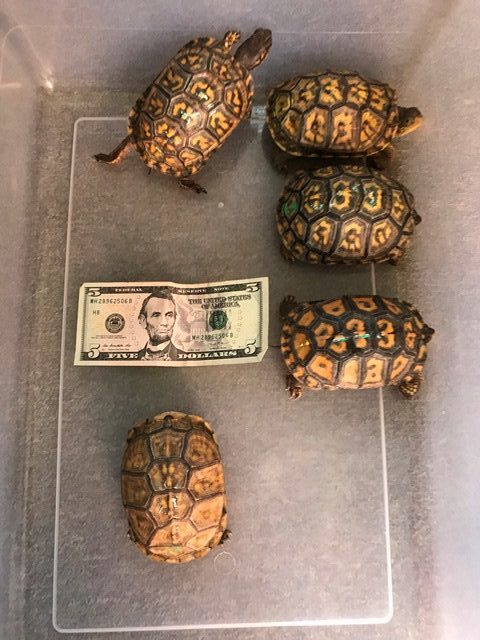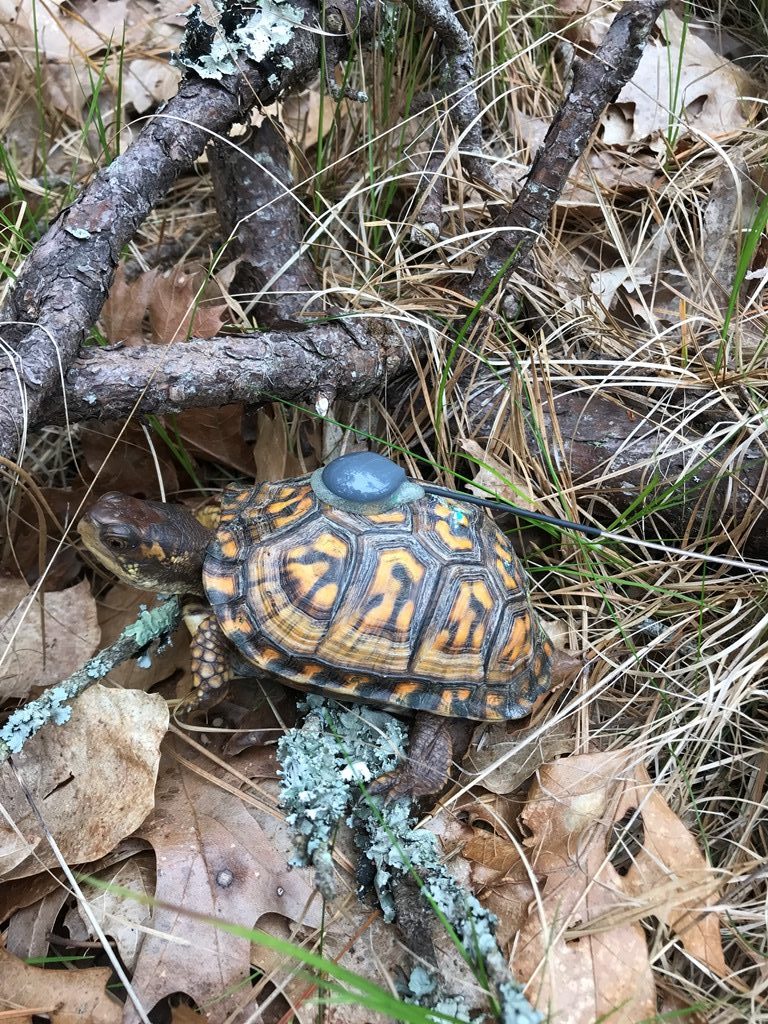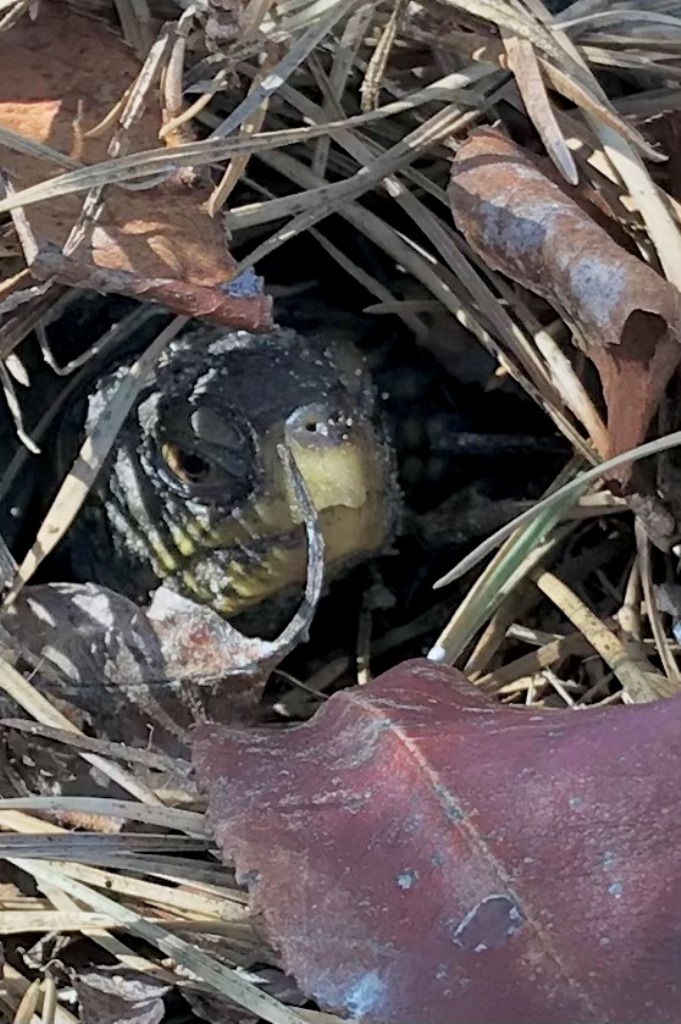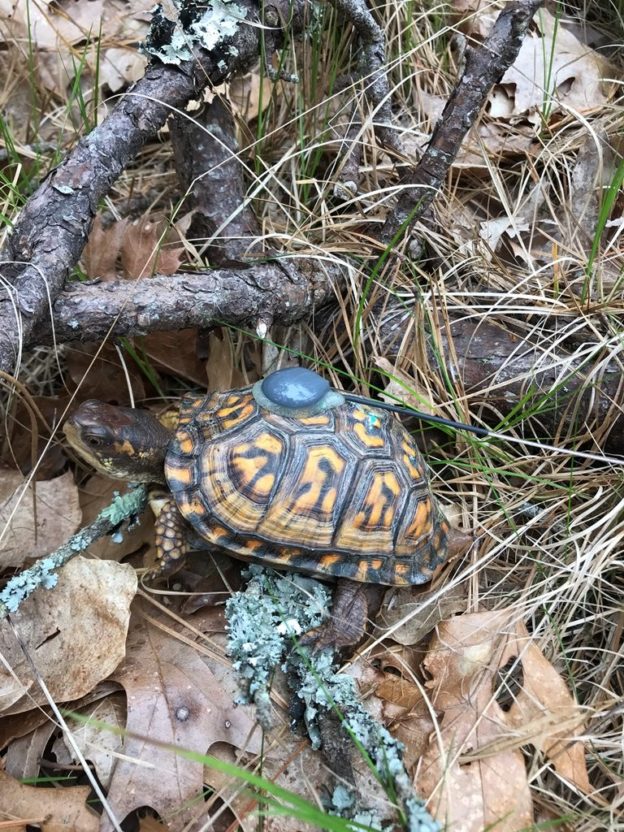The arrival of spring brings the emergence of the sanctuary’s eastern box turtle population, six to seven months after they began their transition to brumation (reptile hibernation) in the fall.
One of our exciting box turtle projects last year was the release of five headstarted box turtles reared by students at Bristol Agricultural High School in Dighton.

just before they were released at the sanctuary last May. (Photo by Tim O’Brien)
These turtles originated on property that abuts the sanctuary in late 2018. The folks at Bristol Aggie kept them until May of 2020 when each turtle’s average weight was about 200 grams—approximately that of a 4–5-year-old turtle! At that weight, the shell begins to ossify and the plastral hinge is functioning, allowing them to fully withdraw into their shell and resist predators. We released all five on the sanctuary property last May, equipped with radio transmitters, and have been monitoring their progress since.

Last summer was hot and dry, and in the fashion of young turtles, our headstarts spent most of their time hidden. We released them in different areas of the sanctuary and after some initial movement, they settled in. Over the entire season, we monitored their weights to make sure they were eating and maintaining hydration. They all sustained their weight and a couple actually gained some weight. I looked in on them 2-3 times per month. One turtle’s radio transmitter failed, so the whereabouts of that animal remains unknown, although it’s likely still on the property. As turtles begin to emerge this month, I’ll focus on finding that turtle and changing out the bad transmitter.
Because these turtles spent their first two winters in the care of Bristol Aggie, we were keen to learn if they would know how and when to enter into brumation. They all did fine. As is typical of box turtles, most selected brumation sites in the woods and buried themselves in soft detritus. One turtle went its own way and brumated in a field with no canopy cover, unusual but not unheard of. We looked in on them once a month throughout the winter and measured the length and depth of their burrows. And now for answering the big question: How did the head starts fare in brumation?
On a recent warm April afternoon walk, I looked in on the young turtles. All were still in brumation, but one turtle (#86.1), was sitting at the mouth of her burrow with head extended as if contemplating emergence.

I suspect that the cooler weather that immediately followed pushed her back into her burrow to wait for another day, but it is very gratifying to know that she made it through her first brumation cycle! Her temperature data logger will show us the temperatures that she experienced in the burrow all winter. After she emerges, I’ll change out her transmitter and follow her again this year. It is our hope and expectation that she will establish a home territory on the sanctuary property and contribute many offspring over the years. We’ll keep you posted!
Tim O’Brien is a veteran volunteer at Wellfleet Bay and when he’s not tracking down box turtles with his radio antenna, he and his wife Kim Novino are rescuing cold-stunned sea turtles and occasionally injured diamondback terrapins



I love turtles, and also other reptiles & amphibians. Your work with the box turtles is very interesting. Can’t wait to hear more about these 5 special box turtles!!
Well I have learned some new terminology…..wonderful turtle info.
We had one with about a 6-7″ shell on our property in Pocasset for a few years but I haven’t seen him around for awhile. We first met when I was picking low-bush blueberries and nearly jumped out of my skin when a head darted out and snagged one near my hand. It’s good habitat for them, but I’m worried since I haven’t seen him lately.
Hello Wendi:
Box turtles are very good at staying out of sight. Your fellow is likely still in the area, hiding under leaves when he’s not eating blueberries, worm or slugs. There is also a chance that he’s moved on to a new territory with better resources. It’s difficult to know for sure.
Tim
I photod a juvie Box October 20, 2020 on my place in Yarmouth. Also, a pair engaged in mating, and a female laying. Lots of them around here. Am concerned because we abut power lines where Eversource either sprays herbicides or does clearing / cutting annually with heavy machinery ! Have found crushed boxes, too.
Jim W. 508-240-4851.
Hi Jim:
Thank you for your note. The turtles are likely drawn to the open space of the power lines to nest. I agree that cutting and heavy machinery in these areas can be a problem. Many power companies will cut brush during times of the year when the turtles are inactive limiting any potentially negative interactions. If you think that your local box turtle population is at risk, you may want to contact MassWildlife for advice.
Best regards, Tim
Tim, you’re definitely a turtle whisperer! Congratulations to you on your many successes!
So encouraging, going to send this to the school I used to work at before retirement for the students to read. Thanks Tim!
Congratulations ❗️Great news. I’m following your continued results.
What great news ❗️Congratulations on the success of your turtle project. I look forward to your updates.